1995 PONTIAC BONNEVILLE low beam
[x] Cancel search: low beamPage 79 of 338
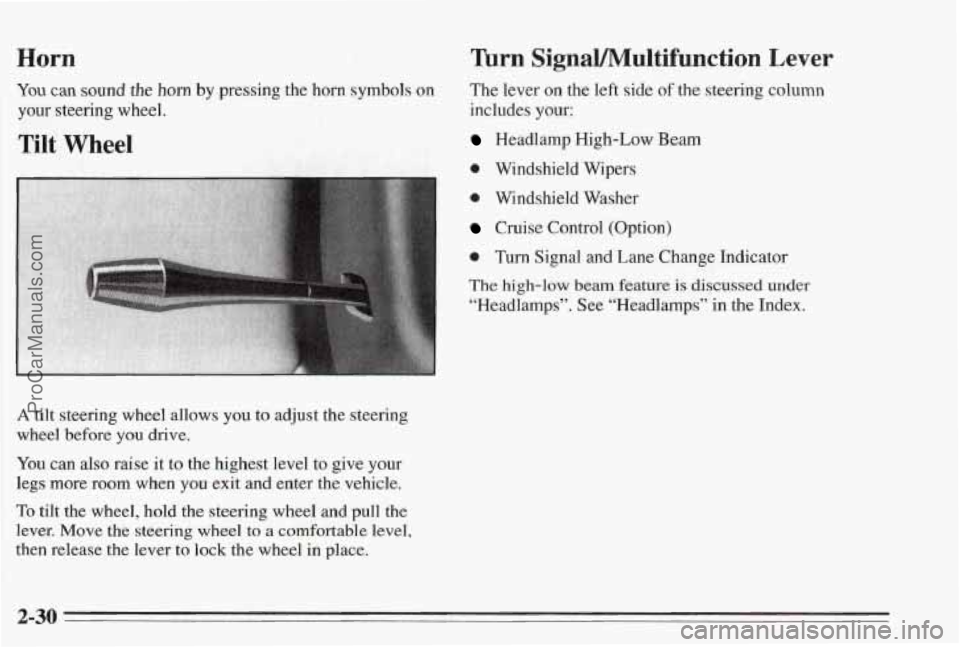
Horn
You can sound the horn by pressing the horn s’ymbols on
your steering wheel.
‘Tilt Wheel
Turn SignaVMultifunction Lever
The lever on the left side of the steering column
includes your:
Headlamp High-Low Beam
0 Windshield Wipers
a Windshield Washer
Cruise Control (Option)
@ Turn Signal and Lane Change Indicator
The high-low beam feature is discussed under
“Headlamps”. See “Headlamps” in the Index.
A tilt steering wheel allows you to adjust the steering
wheel before you drive.
You can
also raise it to the highest level to give your
legs more room when you exit and enter the vehicle.
To tilt the wheel, hold the steering wheel and pull the
lever.
Move the steering wheel to a comfortable level,
then release the lever to
lock the wheel m place.
2-30
ProCarManuals.com
Page 87 of 338
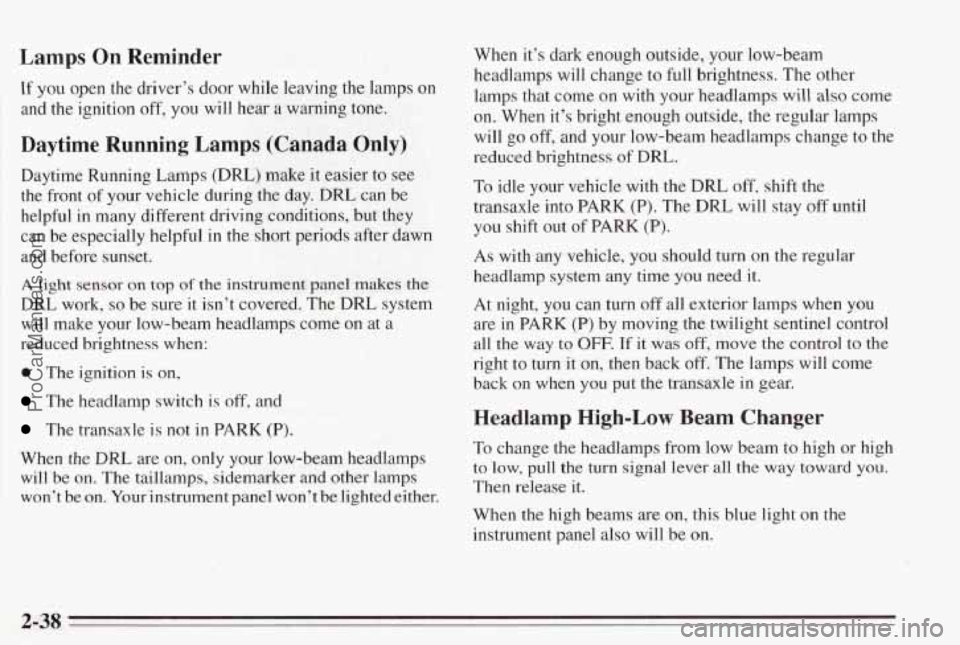
Lamps On Reminder
If you open the driver’s door while leaving the lamps on
and the ignition off, you will hear a warning tone.
Daytime Running Lamps (Canada Only)
Daytime Running Lamps (DRL) make it easier to see
the front of your vehicle during the day. DRL can be
helpful in many different driving conditions,
but they
can be especially helpful in the
short periods after dawn
and before sunset.
A light sensor on top of the instrument panel makes the
DRL work, so be sure it isn’t covered. The DRL system
will make your low-beam headlamps come on at a
reduced brightness when:
0 The ignition is on,
The headlamp switch is off, and
The transaxle is not in PARK (P).
When the DRL are on, only your low-beam headlamps
will be
on. The taillamps, sidemarker and other lamps
won’t be on. Your instrument panel won’t be lighted either. When it’s dark
enough outside, your low-beam
headlamps will change to full brightness. The other
lamps that come on with your headlamps will also come
on. When it’s bright enough outside, the regular lamps
will go
off, and your low-beam headlamps change to the
reduced brightness
of DRL.
To idle your vehicle with the DRL off, shift the
transaxle into
PARK (P). The DRL will stay off until
you shift out of PARK
(P).
As with any vehicle, you should turn on the regular
headlamp system
any time you need it.
At night, you can turn off all exterior lamps when
you
are in PARK (P) by moving the twilight sentinel control
all the way to OFF. If it was off, move the control to the
right
to turn it on, then back off. The lamps will come
back
on when you put the transaxle in gear.
Headlamp High-Low Beam Changer
To change the headlamps from low beam to high or high
to low, pull the turn signal lever all the way toward you.
Then release it.
When the high beams are
on, this blue light on the
instrument panel also will
be on.
2-38
ProCarManuals.com
Page 88 of 338
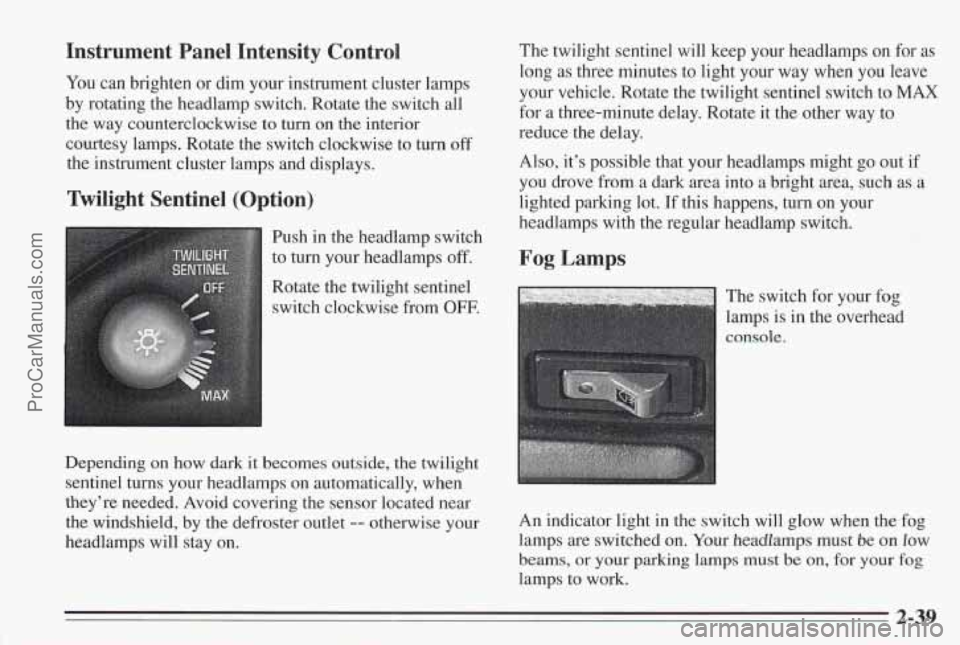
Instrument Panel Intensity Control
You can brighten or dim your instrument cluster lamps
by rotating the headlamp switch. Rotate the switch all
the way counterclockwise to turn on the interior
courtesy lamps. Rotate the switch clockwise to
turn off
the instrument cluster lamps and displays.
Twilight Sentinel (Option)
Push in the headlamp switch
to
turn your headlamps off.
Rotate the twilight sentinel
switch clockwise from
OFF.
Depending on how dark it becomes outside, the twilight
sentinel
turns your headlamps on automatically, when
they’re needed. Avoid covering the sensor located near
the windshield, by the defroster outlet
-- otherwise your
headlamps will stay on. The
twilight sentinel will keep your headlamps on
for as
long as three minutes to light your way when you leave
your vehicle. Rotate the twilight sentinel switch to
MAX
for a three-minute delay. Rotate it the other way to
reduce the delay.
Also, it’s possible that your headlamps might go out if
you drove from a dark area into a bright area, such as a
lighted parking lot.
If this happens, turn on your
headlamps with the regular headlamp switch.
Fog Lamps
The switch for your fog
lamps is in the overhead
An indicator light in the switch will glow when the fog
lamps are switched
on. Your headlamps must be on low
beams, or your parking lamps must be on, for your fog
lamps to work.
2-39
ProCarManuals.com
Page 109 of 338
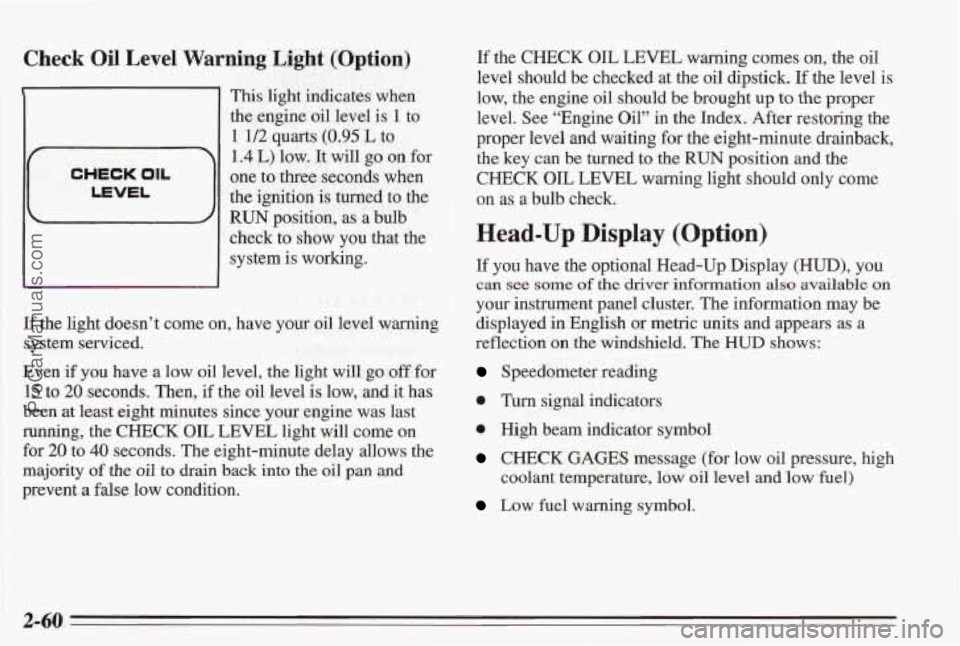
Check Oil Level Warning Light (Option)
1
CHECK OIL
LEVEL
1 This light indicates when
the engine oil level is
1 to
1 1/2 quarts (0.95 L to
1.4 L) low. It will go on for
one to three seconds when
the ignition is turned to the
RUN position, as a bulb
check to show
you that the
system is working.
If the light doesn’t come on, have your oil level warning
system serviced.
Even if
you have a low oil level, the light will go off for
15 to 20 seconds. Then, if the oil level is low, and it has
been at least eight minutes since your engine was last
running, the CHECK OIL LEVEL light will come on
for 20 to
40 seconds. The eight-minute delay allows the
majority of the
oil to drain back into the oil pan and
prevent
a false low condition. If the
CHECK OIL LEVEL
warning comes on, the oil
level should be checked at the oil dipstick. If the level is
low, the engine oil should be brought up
to the proper
level. See “Engine Oil” in the Index. After restoring the
proper level and
waiting for the eight-minute drainback,
the key can be turned to the
RUN position and the
CHECK OIL LEVEL warning light should only come
on
as a bulb check.
Head-Up Display (Option)
If you have the optional Head-Up Display (HUD), you
can see some of the driver information also available on
your instrument panel cluster. The information may be
displayed in English or metric units and appears as
a
reflection on the windshield. The HUD shows:
Speedometer reading
0 Turn signal indicators
e High beam indicator symbol
CHECK GAGES message (for low oil pressure, high
coolant temperature, low oil level and
low fuel)
Low fuel warning symbol.
2-60
ProCarManuals.com
Page 116 of 338
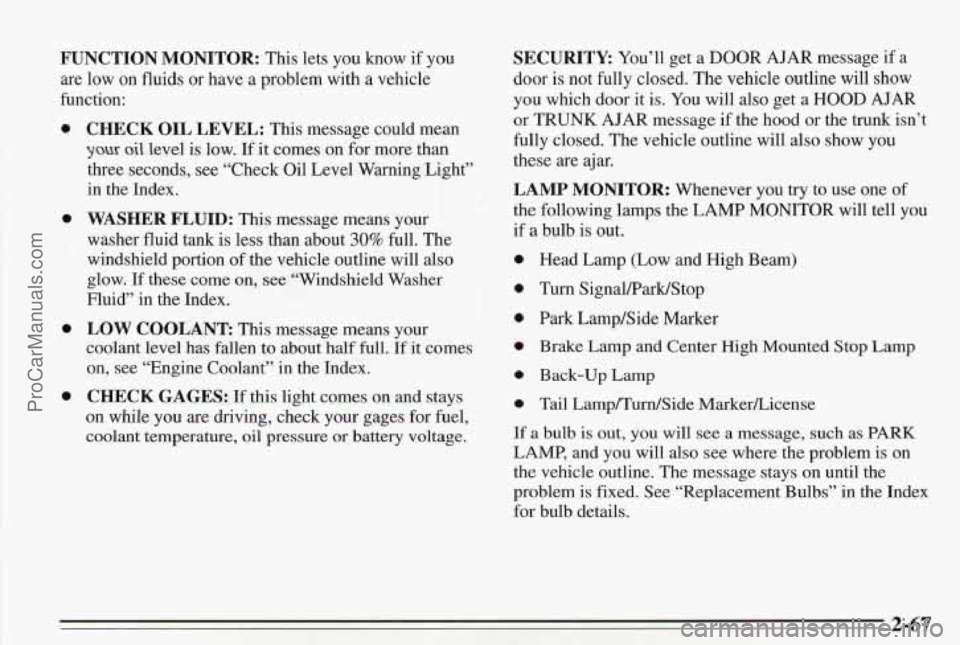
FUNCTION MONITOR: This lets you know if you
are low on fluids or have a problem with a vehicle
function:
0
0
0
0
CHECK OIL LEVEL: This message could mean
you oil level is low. If it comes on for more than
three seconds, see “Check Oil Level Warning Light”
in the Index.
WASHER FLUID: This message means your
washer fluid tank is less than about
30% full. The
windshield portion of the vehicle outline will also
glow.
If these come on, see “Windshield Washer
Fluid” in the Index.
LOW COOLANT This message means your
coolant level has fallen
to about half full. If it comes
on, see “Engine Coolant”
in the Index.
CHECK GAGES: If this light comes on and stays
on while you are driving, check your gages for fuel,
coolant temperature,
oil pressure or battery voltage.
SECURITY: You’ll get a DOOR AJAR message if a
door
is not fully closed. The vehicle outline will show
you which door it is.
You will also get a HOOD AJAR
or TRUNK AJAR message if the hood or the trunk isn’t
fully closed. The vehicle outline will also show you
these are ajar.
LAMP MONITOR: Whenever you try to use one of
the following lamps the LAMP MONITOR will tell you
if
a bulb is out.
Head Lamp (Low and High Beam)
Turn SignaWarWStop
Park Lamp/Side Marker
Brake Lamp and Center
High Mounted Stop Lamp
Back-up Lamp
Tail Lamp/Turn/Side MarkerLicense
If
a bulb is out, you will see a message, such as PARK
LAMP, and you will also see where the problem is on
the vehicle outline. The message stays on until the
problem is fixed. See “Replacement Bulbs” in the Index
for bulb details.
2-67
ProCarManuals.com
Page 117 of 338
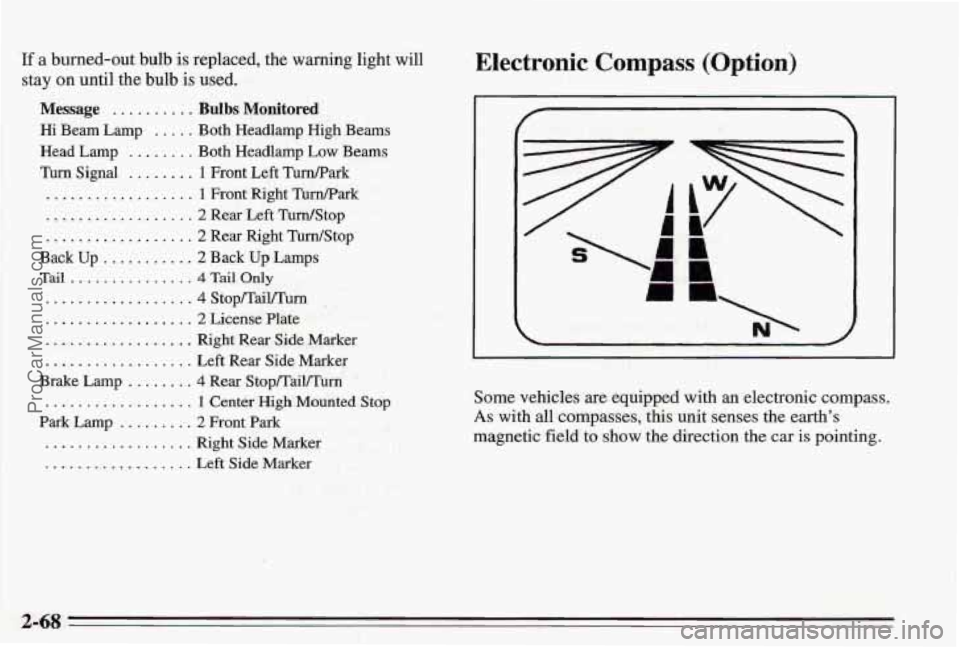
If a burned-out bulb is replaced, the warning light will
stay on until the bulb is used.
Message .......... Bulbs Monitored
Hi Beam Lamp ..... Both Headlamp High Beams
Head Lamp
........ Both Headlamp Low Beams
Turn Signal ........ 1 Front Left Turn/Park
.................. 1 Front Right TuWark
.................. 2 Rear Left WStop
.................. 2 Rear Right Turdstop
Back Up
........... 2 Back Up Lamps
Tail ............... 4 Tail Only
.................. 4 stopnaim
.................. 2 License Plate
.................. Right Rear Side Marker
.................. Left Rear Side Marker
Brake Lamp ........ 4 Rear Stop/Tail/Tun
Park Lamp ......... 2 Front Park
.................. 1 Center High Mounted Stop
.................. Right Side Marker
.................. Left Side Marker
Electronic Compass (Option)
Some vehicles are equipped with an electronic compass.
As with all compasses, this unit senses the earth’s
magnetic
field to show the direction the car is pointing.
ProCarManuals.com
Page 158 of 338
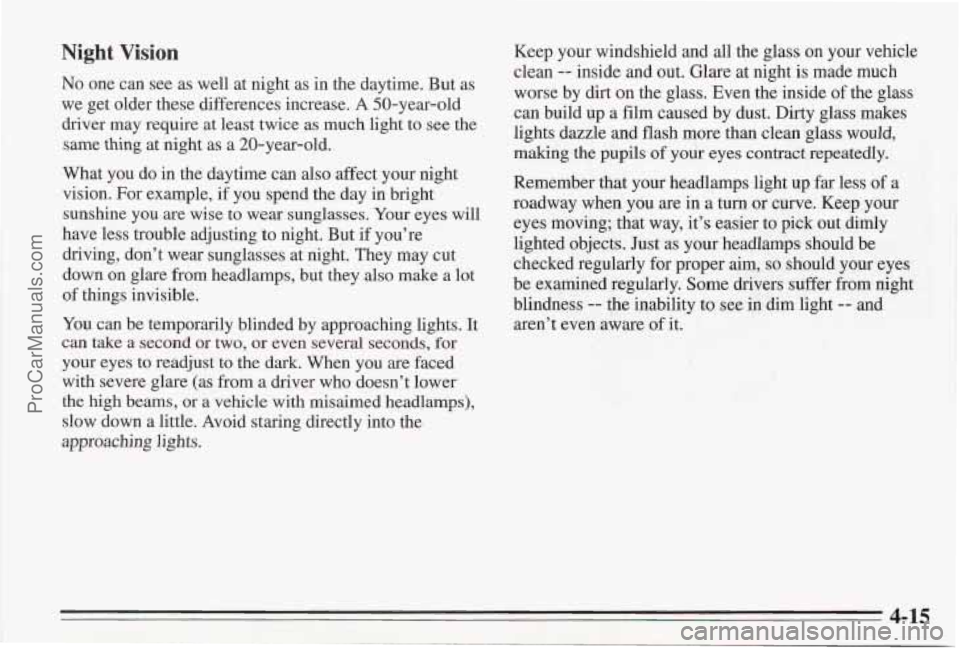
Night Vision
No one can see as well at night as in the daytime. But as
we get older these differences increase. A 50-year-old
driver may require at least twice as much light to see
the
same thing at night as a 20-year-old.
What you do in the daytime can also affect your night
vision. For example, if you spend the day in bright
sunshine you
are wise to wear sunglasses. Your eyes will
have less trouble adjusting
to night. But if you’re
driving, don’t wear sunglasses at night. They may cut
down on glare from headlamps, but they also make a lot
of things invisible.
You can be temporarily blinded by approaching lights. It
can take a second
or two, or even several seconds, €or
your eyes to readjust to the dark. When you are faced
with severe glare (as from
a driver who doesn’t lower
the high beams, or a vehicle with misaimed headlamps),
slow down a little. Avoid staring directly into the
approaching
lights.
Keep your windshield and all the glass on your vehicle
clean
-- inside and out. Glare at night is made much
worse by dirt on the
glass. Even the inside of the glass
can build up a film caused by dust. Dirty glass makes
lights dazzle and flash more than clean glass would,
making the pupils of your eyes contract repeatedly.
Remember that your headlamps light up far less
of a
roadway when you
are in a turn or curve. Keep your
eyes moving; that way, it’s easier to pick out dimly
lighted objects. Just as your headlamps should be
checked regularly for proper aim,
so should your eyes
be examined regularly. Some drivers suffer from night
blindness
-- the inability to see in dim light -- and
aren’t even aware of it.
..
4-15
ProCarManuals.com
Page 161 of 338
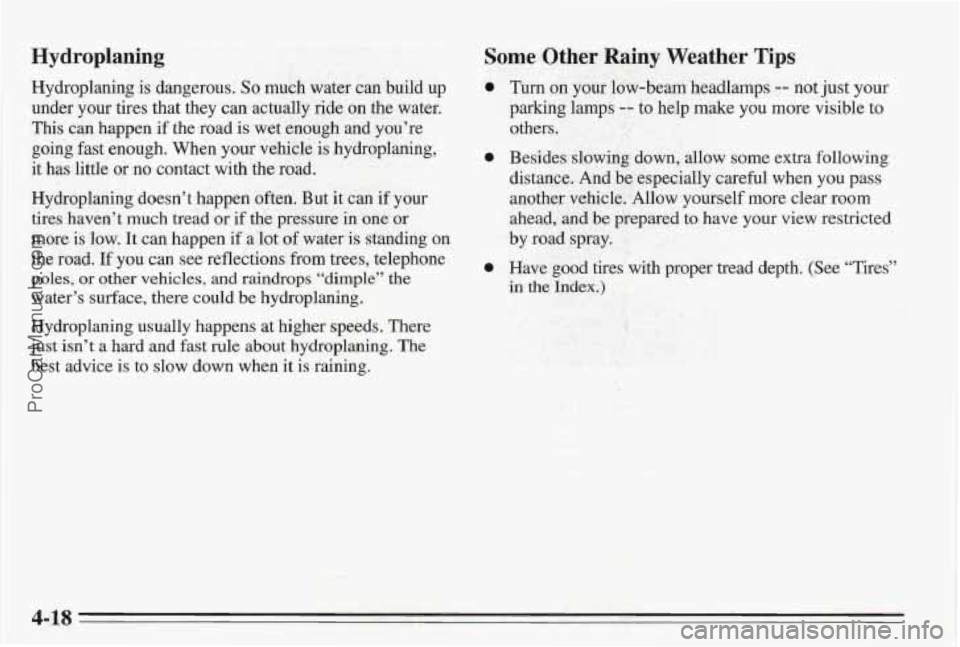
Hydroplaning
Hydroplaning is dangerous. So much water can build up
under your tires that they can actually ride on the water.
This can happen if the road is wet enough
and you’re
going fast enough. When
your vehicle is hydroplaning,
it has little or no contact with the road.
Hydroplaning doesn’t happen often. But it can
if your
tires haven’t much tread or if the pressure
in one or
more is low. It can happen if a lot
of water is standing on
the road. If you can see reflections from trees, telephone
poles, or other vehicles, and raindrops “dimple” the
water’s surface, there could be hydroplaning.
Hydroplaning usually happens at higher speeds. There
just isn’t
a hard and fast rule about hydroplaning. The
best advice
is to slow down when it is raining.
,.<, ., .- ’ ,”.’ ’ - ’ .. c ,. . - :. .
Some Other Rainy Weather Tips
0 Turn on your low-beam headlamps -- not just your
parking lamps
-- to help make you more visiblle to
others.
0 Besides slowing down, allow some extra following
distance. And
be especially carefial when you pass
another vehicle. Allow yourself more clear room
ahead,
and be prepared to have your view restricted
by road spray.
0 Have good tires with proper tread depth. (See “Tires”
in the Index.)
4-18
ProCarManuals.com